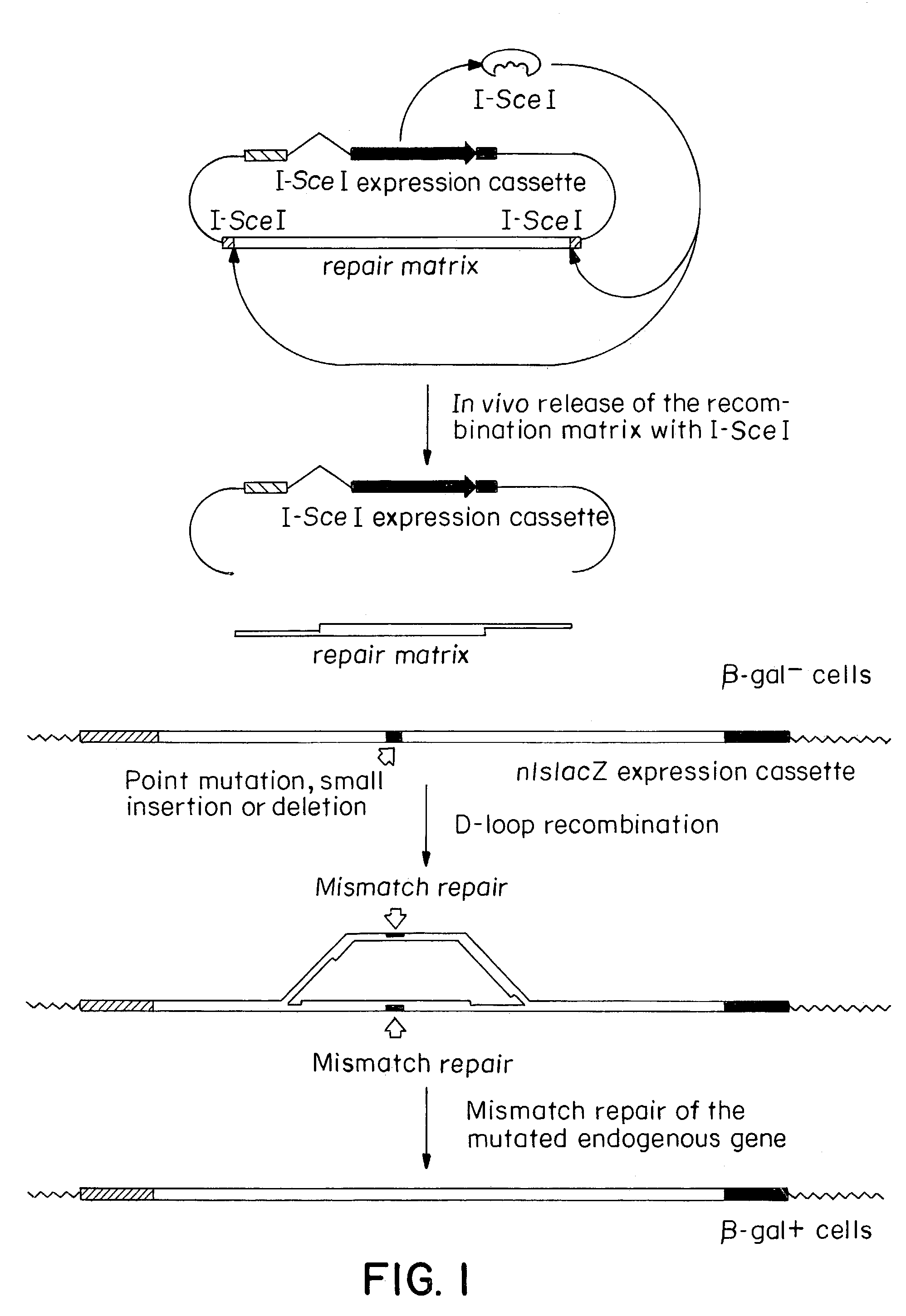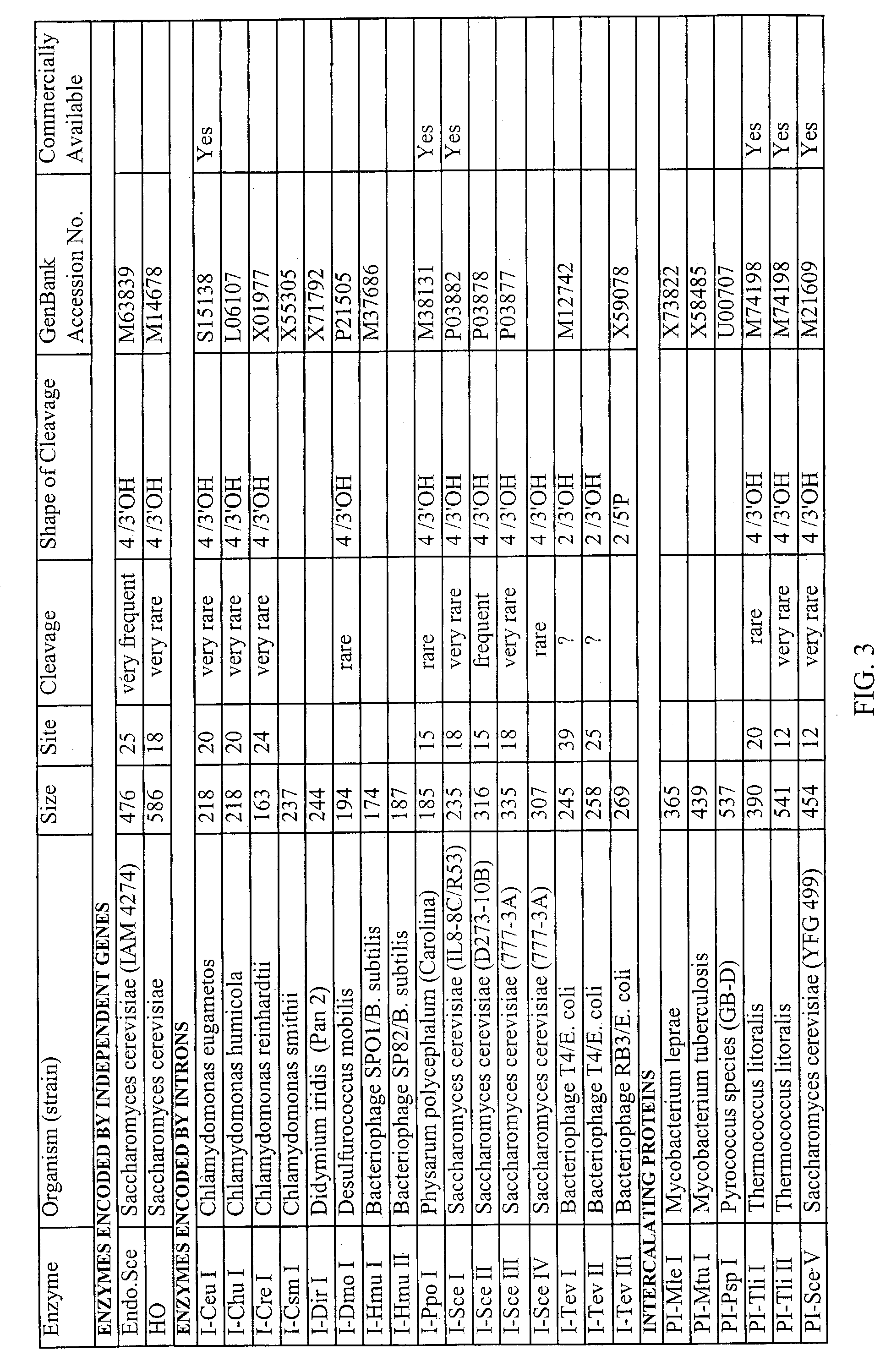Gene repair involving in vivo excision of targeting DNA
a technology of in vivo excision and gene repair, which is applied in the direction of biocide, genetic material ingredients, drug compositions, etc., can solve the problems of inherently inefficient methods for homologous recombination, and achieve the effect of increasing the frequency of homologous recombination
- Summary
- Abstract
- Description
- Claims
- Application Information
AI Technical Summary
Benefits of technology
Problems solved by technology
Method used
Image
Examples
example 1
Plasmid Construction
[0056]All DNA manipulations used standard techniques and procedures. Such methods are described, for example, in Sambrook et al., Molecular Cloning. A Laboratory Manual, Second Edition, Cold Spring Harbor University Press, New York (1989); and Ausubel, et al., Current Protocols in Molecular Biology, John Wiley & Sons, New York (1998). All synthetic oligonucleotides were synthesized on automated instruments using standard techniques.
[0057]The p2Wlac plasmid was constructed as follows: First, the pPytknlslacZ plasmid (Henry et al., C. R. Acad. Sci. III, 322(12):1061-1070 (1999)) was digested with the SpeI and HindIII restriction enzymes, resulting in excision from the plasmid of a 578 bp fragment containing the ATG start codon and 178 bp at the 5′ end of the coding region of the nlslacZ gene. Second, the oligonucleotide 5′-CTAGATGCATAGGGATAACAGGGTAAT-3′ (SEQ ID NO: 1), paired with 5′-AGCTATTACCCTGTTATCCCTATGCAT-3′ (SEQ ID NO: 2), was inserted into the SpeI-HindIII ...
example 2
Cell Line Production and D-loop Recombination: Correction of a 4 Base Pair Insertion
[0065]5 μg of the pPytknlslacZDBcl plasmid and 5 μg of the pUSVneo plasmid were co-transfected into 5×104 NIH 3T3 cells (American Type Culture Collection) in a 35 mm petri dish (Falcon) using the CaPO4 precipitation method. 48 hours after transfection, the tissue culture medium was supplemented with 600 μg / ml of Geneticin (Gibco BRL). Antibiotic selection was maintained during selection of Geneticin resistant clones and during subcloning. Forty-eight (48) Geneticin resistant clones were isolated and grown independently in Dulbeccos modified Eagles Medium (DMEM), 10% calf serum, for 15 days before evaluating for the presence of the nlslacZ gene.
[0066]To evaluate for presence of the nlslacZ gene, DNA was extracted from cells in all 48 cultures of Geneticin resistant clones. Fragments of the nlslacz gene were amplified by polymerase chain reaction (PCR) as described in BioFeedback in BioTechniques, Hanl...
example 3
Cell Line Production and D-loop Recombination: Correction of a 4 Base Pair Deletion
[0075]5 μg of the pPytknlslacZΔBcl plasmid and 5 μg of the pUSVneo plasmid were cotransfected in 5×104 NIH 3T3 cells (American Type Culture Collection) in a 35 mm petri dish (Falcon) using the CaPO4 precipitation method. 48 hours after transfection, the tissue culture medium was supplemented with 600 μg / ml of Geneticin (Gibco BRL). Antibiotic selection was maintained during selection of Geneticin resistant clones and during subcloning. Forty-eight (48) Geneticin resistant clones were isolated and grown independently in Dulbeccos modified Eagles Medium (DMEM), 10% calf serum, for 15 days before evaluating for the presence of the nlslacZ gene.
[0076]To evaluate for presence of the nlslacZ gene, DNA was extracted from cells in all 48 cultures of Geneticin resistant clones. Fragments of the nlslacZ gene were amplified by PCR as described in BioFeedback in BioTechniques, Hanley & J. P. Merlie, Vol. 10, No. ...
PUM
| Property | Measurement | Unit |
|---|---|---|
| frequency | aaaaa | aaaaa |
| ) frequency | aaaaa | aaaaa |
| nucleic acid sequence | aaaaa | aaaaa |
Abstract
Description
Claims
Application Information
 Login to View More
Login to View More - Generate Ideas
- Intellectual Property
- Life Sciences
- Materials
- Tech Scout
- Unparalleled Data Quality
- Higher Quality Content
- 60% Fewer Hallucinations
Browse by: Latest US Patents, China's latest patents, Technical Efficacy Thesaurus, Application Domain, Technology Topic, Popular Technical Reports.
© 2025 PatSnap. All rights reserved.Legal|Privacy policy|Modern Slavery Act Transparency Statement|Sitemap|About US| Contact US: help@patsnap.com



